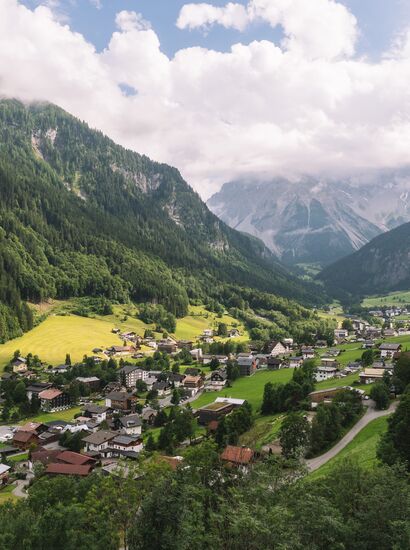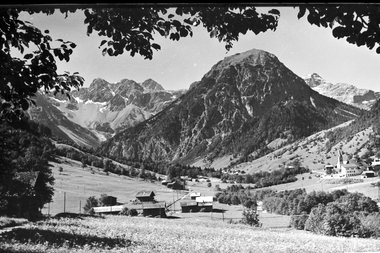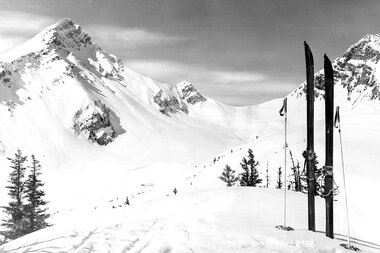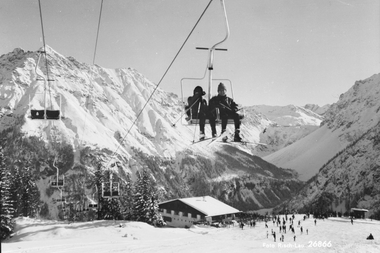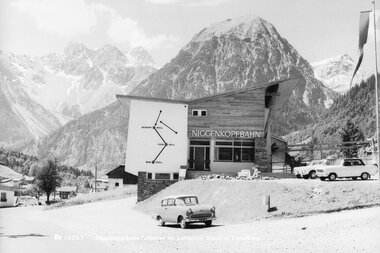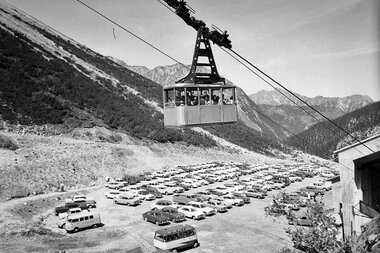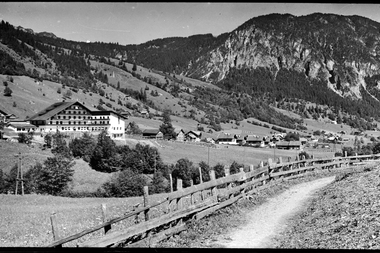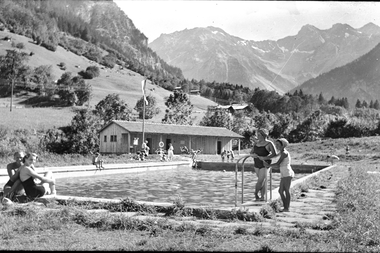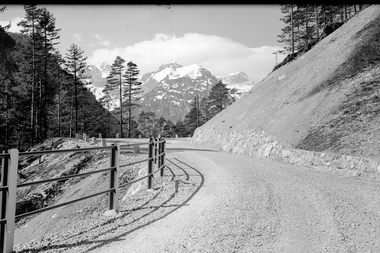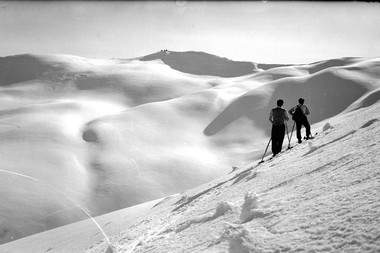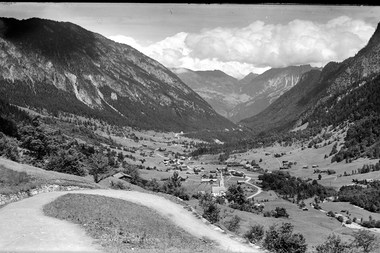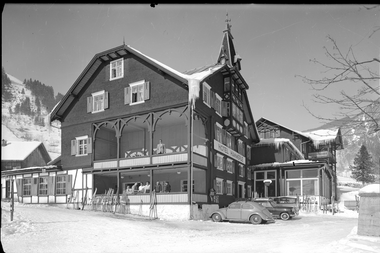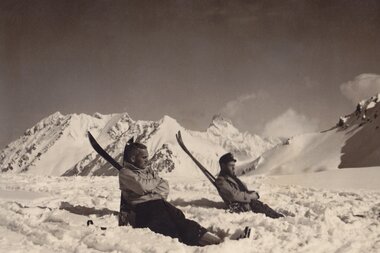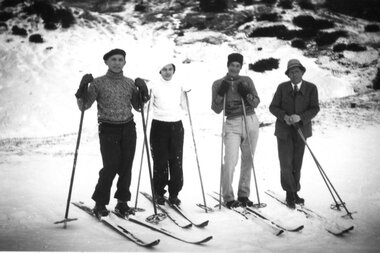The Cultural History of Brand
The development of a special mountain village
The mountain village of Brand lies at the end of the valley at almost one thousand meters above sea level. It belongs to Vorarlberg, Austria's westernmost province, and borders the Prättigau in the Swiss canton of Graubünden to the south-west with the main ridge of the Rätikon.
Brand is a Walser settlement. The original home of the first inhabitants is in Goms, in the upper Rhône valley, in today's canton of Valais in western Switzerland. This is where the so-called Walser migrations began in the 13th and 14th centuries, leading across the Alps in all directions. The people of Valais obviously led a hard life at the time, otherwise they would not have thought of emigrating and seeking a new home in a foreign country. It is not really known what hardships forced them to do so. Was it the large number of children that caused overpopulation? Was it natural disasters, climate change or epidemics? Was it the hardships of war and oppression by the aristocratic lords of the manor? Or was it simply the desire for adventure? No one can be asked today. But the Walser settlements in Graubünden, Liechtenstein and Vorarlberg, as well as in Piedmont south of the main Alpine ridge, owe their population to all these circumstances.
The Brandnertal lies in the middle of the Rätikon mountains and is drained by the Alvier, which has its source at the leaks of the Lünersee lake. In the area of the "Schattasitner Wiesa" it joins the glacier stream. Shortly afterwards, it plunges around 40 meters over the Brandner "Kessifall" into an impressive deep gorge with well-developed water mills. In the middle of the 19th century, people, especially those from the cities, discovered their love for the mountains. With the growing enthusiasm, they saw the mountains more with admiration and less with fear. The Brandnertal with its magnificent mountain scenery was particularly attractive to alpinists. The real upswing in alpinism began in 1869 with the founding of the German Alpine Club and the Vorarlberg section.
Source: A LOOK AT THE WALSERGEMEINDE BRAND BY MANFRED BECK
Dipl. Ing. Manfred Beck Former mayor and former member of the provincial parliament in 2020
Brand village chronicle: A journey through the history of Brand
Before 1300 until 1499
Before 1300
Shepherds and hunters occasionally roamed the wooded area of today's village of Brand, which was long considered uninhabitable due to its inhospitable appearance. In the 13th century, the Valais, Switzerland's upper Rhone valley, saw the departure and partial abandonment of the mountain areas. The reasons for this are likely to have been the abundance of children in the families and the unusability of some properties due to mudslides and avalanches. Many of these families moved eastwards to Graubünden, Lichtenstein and Vorarlberg and founded new Walser settlements in uninhabited and inaccessible mountain areas.
After 1300
Immigration of free Walsers into the high valley of Brand; these were Walser colonists who probably came over the Colrosa pass from the Praetigau region (Walser settlement of Stürvis on the southern slopes of the Rätikon), which was also populated by Walsers. The first settlers mentioned in the feudal charter of 1347 will have brought their wives and children, as well as their livestock, to the valley after scouting out their new home and building their first dwellings and stables.
1347
First document about Brand (dated December 7, 1347), according to which the Valavier valley is granted to the Valaisans in exchange for a fief. The boundaries of the municipality are also defined.
1410 (August 24)
The lepers Hensle Aleman and his son Jösli donate their property to the chapel in Brand with the help of Count Hartmann von Werdenberg. Construction of the chapel in Brand begins in the same year.
1423
The now completed chapel and cemetery are consecrated by Frater Pantaleon, Vicar of Bishop Johannes of Chur.
1454
Count Wilhelm von Sargans wants to make the Walser people living in the Brandnertal valley serfs.
1474
The County of Sonnenberg, and therefore also Brand, is sold to the House of Habsburg for 35,000 guilders. Duke Siegmund of Austria unites the county with Bludenz and has it administered by bailiffs.
1476
Bishop Ortlieb of Chur allows baptism, the celebration of the Holy Sacrament in the chapel in Brand and a chaplain of his own with the consent of the parish priest and the church in Bürs.
1478
The chapel in Brand is demolished and church construction begins. Five named cardinals issue a letter of indulgence to the chapel in Brand.
1499
In the so-called Swabian War, Swiss troops fight against the imperial army in the Battle of Frastanz. Many free Walser in Vorarlberg are subject to the authorities. The bloodiest battle in Vorarlberg's history takes place on April 20. Dozens of free Walsers are slain or drown in the River Ill in a single day. This stroke of fate prompted many Walser communities to give up their freedom. From then on, they no longer had to go to war, but became serfs. The Walser living in Brand retain their freedom.
1507 to 1790
1507
After 27 years of construction, the parish church of Maria Himmelfahrt is consecrated by the Auxiliary Bishop of Chur, Stephan Tschuggli. The frescoes on the church walls date from this time.
1546
Clas Beck is carelessly shot by his brother Christian and Paul Geiger while hunting.
1563
The assets of Claus Steffan and Kaspar Dünser from Brand are confiscated for poaching. Both had fled from Brand. Hans Lennz von Brunnenfeld, who had been caught, is imprisoned and receives a long prison sentence.
1590
A bear is shot by hunters on Brand territory after a long drive hunt.
1597
In June 1597, the largest known witch trial in the Oberland takes place in Bludenz, which also costs the lives of 3 people from Brand. Mrs. Elsa Dünserin, her husband Thomas Flisch and her sister Barbara Dünserin were sentenced by the Maleficent Court in Bludenz alongside other accused and burned at the stake. In the same year, two women from Brand are also acquitted because they are unwilling to confess despite being tortured.
1617 - 1628
The well-known priest, healer and "witch finder" Luzius Hauser takes over the pastorate in Brand. Hauser begins to write the first baptismal register with his records.
around 1622
The religious war rages in Prättigau. During this time, the bride and groom Elisabeth Sentin and Johann Lampert flee to Brand, providing the historical background to the "Legend of the Spusagang".
1630
The plague also claims its victims in Brand
1727
Brand gains independence as a parish and political municipality. At this time, Brand has around 200 inhabitants.
1782
A bear is sighted on Brand's municipal land, which after a short hunt migrates to the Gamperdonatal. Brand sets 96 daily watches to drive the bear away.
1790
The community's request for a larger bell, because the ringing was too weak, is rejected by the bailiff's office in Bregenz.
1800 to 1897
1800
The organ builder Johann Michael Gassner builds an organ for the church in Brand.
1804
(Bürserberg) After the forest on the "Burtscha" was extensively felled in 1796 to create pastureland, the first catastrophic floods occur in 1800 after heavy storms, which would ultimately lead to the largest mudslide in Europe in the years to come.
1805 until 1814
Vorarlberg, and thus also Brand, belong temporarily to Bavaria. During this time, Vorarlberg's 24 courts are dissolved and 96 municipalities are created as the smallest administrative unit. Jurisdiction and administration are thus separated. The Sonnenberg court is relocated to Bludenz.
1816
Brand is ceded from the diocese of Chur to the diocese of Brixen (South Tyrol).
1820 to 1830
Construction of a cart track from Bürs to Brand according to the plans of the district engineer Alois Negrelli. Before 1820, only a simple mule track led into the valley below the rocks of the Taleukopf.
1830 (February 22)
Johann Josef Schwald, his two sons Christian and Peter and the helper Anton Beck are caught in an avalanche and fatally injured while pulling hay on the Vilbona.
1834
Christian Getzner, Franz Xaver Mutter and Andreas Gassner found the company Getzner Mutter und Cie in Bludenz. Many Brandner residents set up veritable weaving cellars in their homes. Pastor Franz Mäser writes in his parish chronicle that around 40 women weave cotton on their looms for the newly founded company.
1848 (September 7)
First known ascent of the Zimba, by the fountain maker Anton Neyer from Bludenz single-handedly.
1848 (All Saints' Day)
Three new church bells are hoisted onto the Brandner church tower. Three bells already in the tower are roped down and melted down. The smallest of these bells still hangs in the tower until the First World War. This bell falls victim to the First World War on September 22, 1916.
1857 (November 24)
At around 4 a.m., a large fire breaks out in the Brandner Flur due to carelessness and spreads rapidly. Supported by a gale-force foehn gale, the entire meadow is soon ablaze. Fire crews from Bürserberg, Bürs, Bludenz, Nüziders, Ludesch, Thüringen, Bludesch, Nenzing, St. Anton, Vandans and Schruns rush to the aid of the firefighters. On the evening of November 25, the storm subsides and the onset of rain and snow extinguishes the last pockets of embers.
1868
The Fidelis altar is sold to the Capuchin monastery in Feldkirch for 189 guilders. It is placed in the Fidelis Chapel.
Before 1870
Opening of the "Mühle" inn. The innkeeper is Baptist Nesler, who transports the weekly ration of wine from Bludenz to Brand in his "Tschopasack". The property is later renamed Hotel Beck following the purchase and extension by Franz Adam Beck.
1870
Construction of the first accommodation hut on Lake Lünersee. This first small hut was built by Samuel Kegele from his own funds with the support of the German Alpine Club, to which the Vorarlberg section belonged at the time, as the first Alpine Club hut in Vorarlberg.
1872
With the inauguration and opening of the Vorarlberg Railway Lindau - Bludenz, the Brandnertal receives a lively influx of hiking guests. With the opening of the Arlberg tunnel on September 21, 1884, Vorarlberg is connected to the rest of Austria by rail.
1876
A dust avalanche destroys the Lünerseehütte, which opened in 1971. The hut is immediately rebuilt. However, Samuel Kegele and Mayor Wolf are unable to finance the reconstruction, so the Alpine Club takes over the financing.
1877
Last big bear hunt in the Gauertal
1877 (August 31)
At around 21:00, Brand is hit by a heavy thunderstorm. The hail is so heavy that the windows of the houses are broken. The tall grass in the fields is crushed by the hail and lies on the ground. Hailstones cover the fields until the next morning.
1879
Enlargement of the cemetery and addition of a new sacristy.
1880/81
Further avalanche damage to the Douglasshütte and construction of an avalanche protection wall.
1881 (18 January)
The Brandner Franz Adam Beck and Bernhard Meyer are certified as mountain guides in Bregenz. They are followed five years later by Johann Meyer and Philipp Bitschi.
1882
Franz Adam Beck moves from his parents' house near the church to Mühledörfle, an old farmhouse. It is said to have been used for catering in the past. The purchase contract for this small "Hämatle" is not signed until 17 September 1885.
1886
The summit of the Schesaplana is treated with explosives to provide enough space for the summiteers.
1890
The Galaferda bridge is vaulted with stone.
1890
There are 10 authorized mountain guides in Brand. The guides are always keen to find new hiking routes so that they can be the first to offer them to guests.
1892
An electric lighting system is ceremoniously put into operation in the Hotel Beck.
1897
55 active farmers from Brand join forces and found a cattle breeding cooperative. This cooperative is converted into an association in 1910 for tax reasons.
1897
The Schattenlagan hut in Seetal is inaugurated by Pastor Dönz. The first tenant of the hut is also its builder, Vinzenz Gassner.
1900 to 1999
1898
Fourteen young men from Brand found a music band (Musikbande). They take out a loan of 100 crowns to buy musical instruments. The bandleader is Christian Graß from Bürs. This band disbands again in 1904.
1899/1900
On New Year's Eve, Viktor Sohm climbs the Schesaplana on skis accompanied by the Lindau customs officers Josef Ostler and Hermann Hartmann.
1901 (01 November)
A K. K. A K. K. telephone extension with year-round operation is put into operation at the Hotel Beck.
1902
A pointed spire is added to the church tower in Brand. After demolition of the existing saddle roof, the tower is raised by six meters.
1902
Locals Eduard and Paul Meyer attend the first ski course in the Eastern Alps in St. Christoph am Arlberg, under the direction of Prof. Paulkes and Dr. Gruber.
1902 and 1904
King Carol of Romania visits Brand with his wife Elisabeth zu Wied (Carmen Sylva).
1903
Foundation of the Brand Beautification Association. According to the statutes, the following objective is pursued: The purpose of the association is the perception and the promotion of all that seems suitable to contribute to the beautification of the village of Brand and its surroundings as well as to the preservation of the amenities of the population and the foreigners. This association is renamed the Brand Tourist Association around 1930.
1904/05
Construction of the Straßburger Hütte on the Brandner Glacier and the Oberzalim Hütte in the Zalimtal.
1905
Franz Adam Beck builds the Jägerheim, which serves as a home for the "publicans".
1908
An avalanche breaks out on the Mottakopf, causing numerous window panes in the village to shatter. The snow dust reaches as far as the Grünen-Wald. There are no human casualties.
1908
The semi-detached house ("Chrescht-Becka") is completely destroyed by fire. Two Brandner families (Bitschi and Kegele) become homeless. There are calls for the purchase of a fire engine. This fire engine is purchased in 1909.
1910
Storms with flooding in Brand cause extensive damage. All the bridges are torn away.
1912
The winter of 1911/12 is so mild that it is never possible to use a snow sledge to Bludenz throughout the winter.
1913/14
Construction of the Sacred Heart Chapel in the Inner Valley begins (work is interrupted due to the outbreak of war). Completion of the chapel in 1918. The parish priest at the time, Thomas Küng, wanted "Mary of Good Counsel" to be the patron saint of the chapel. Many people in Branden think they already have a church dedicated to the Virgin Mary and a chapel dedicated to St. Anne. So the chapel is dedicated to the heart of Jesus.
1914
Outbreak of the First World War. 50 men from Brand join the war between 1914 and 1918. Brand has 12 fallen soldiers to mourn.
1916 (September 22)
The church bells of Brand have to be delivered in stages, and the bell of the Lourdes Chapel also falls victim to the turmoil of the First World War. Before the bells are removed, a ceremonial farewell ringing takes place at 7:30 in the morning.
1917
The Beck and Schesaplana hotels are closed due to poor business and a lack of drinks.
1926
The gendarmerie post is moved from Wald am Arlberg to Brand. The post is located at Otto Kegele (Gasthof Valbona) until 1927. The post is moved to Bürserberg until 1940 and then returns to Brand to the house of Leander Dünser. From 1946, the post moves to the old customs house and from 1960 to the middle of the five customs houses.
1929
The brothers Alois and Richard Kegele open the first swimming pool in the Innertal valley in Brand. Strict laws (morality law) apply to swimming.
1930
Inauguration of the motorway to Brand. Motorized vehicles and semi-open "Saurer buses" reach our town for the first time. The journey is not only expensive, but often also adventurous.
1930
The Brand volunteer fire department is founded. The fact that the founding members are true idealists can be seen from the fact that the firefighters have to buy and pay for their uniform coat and helmet themselves.
1932
By decree dated August 26, Felix Beck is granted permission by the Vorarlberg provincial government to run a ski school in Brand for one year. The second permit is issued on December 21, 1933 for two years and the third, which is no longer limited in time, follows on December 28, 1935.
1932
Last logging in the Alvierbach. There was a hermitage for the drift in the Schattenlagant.
1932 (October 11)
At around 08:00 in the evening, the new building of the Schesaplana Hotel burns down completely. The cause of the fire is thought to be a faulty chimney. The main building itself is spared from the fire. The fire brigades from Brand, Bludenz and Bürs arrive at the scene of the fire.
1933 (27 May)
The Nazi regime in Germany imposes a thousand-mark ban on travelers to Austria. From now on, German citizens have to pay a fee of 1000 Reichsmarks when crossing the border into Austria. The aim of this ban is to weaken the Austrian economy, which is already heavily dependent on tourism at this time.
1938
On March 11, 1938, the National Socialists forcibly seize power in Vorarlberg. Two days later, Austria is annexed to the German Reich. The publication of some Vorarlberg magazines is stopped by the authorities. From March 17, 1938, the Reichsmark is introduced as a means of payment: 3 schillings correspond to approx. 2 Reichsmark.
1938/39
The customs houses are built and provide living space for 10 families of customs officers.
1942
During restoration work in the parish church, previously hidden frescoes are discovered under four layers of plaster.
1945
End of the Second World War. Brand has 27 fallen soldiers to mourn.
1947 (March 09)
The Hotel Schesaplana burns down completely at around 2 o'clock in the afternoon. The old and new parts of the hotel, the post office building and Kaspar Kegele's house and stable are destroyed by the flames. As the fire department's equipment shed is also housed in the Hotel Schesaplana, the Brand fire department is literally left homeless.
1949/51
Construction of the new school building. The Bludenz district school board sets the start of lessons for October 1, 1951.
1953
A summit cross is erected on the Mottakopf by those returning from the war.
1955
The municipal council of Brand, under Mayor Othmar Beck, decides to build two tennis courts on the grounds of the Hotel Schesaplana.
1959
The Brand branch of the Austrian Mountain Rescue Service is founded. The task of this group is to assist injured hikers, provide them with first aid and ensure that they are transported out of mostly difficult terrain.
1960
Inauguration of the newly built Douglasshütte on the Staumauer-Port by the ÖAV - Vorarlberg section. The old Douglass hut is demolished and flooded due to the damming of the lake.
1961 (April 10)
The demolition of the sign marks the start of the renovation work on Brand parish church, which was decided in 1960. The church is consecrated on July 5, 1964.
1965
Asphalting and widening of the municipal roads; opening of the new Hotel Hämmerle building.
1965
Master baker Fridolin Meyer carves a Christmas crib from Swiss stone pine for the Brand parish church.
1966
Construction of the Hotel Walliserhof with the first indoor swimming pool in Brand. Construction of the Palüd ski lift and the Melkboden mountain lodge. Opening of the new post office and Raiffeisenbank building.
1967
Extension of the Valbona inn with Walserklause bar
1969
Addition of the Hotel Schesaplana (Schesa Taverna bar and indoor swimming pool hotel). Construction of the Zalim and Palüd apartment buildings. Construction of the Palüdbahn and Hubertushaus (self-service restaurant)
1970/71
Construction of the kindergarten on the Pfarrwidum with two nurseries. Previously there had only been a summer kindergarten in the school building for a few months.
1971
The Straßburgerhütte, inaugurated in 1905, is renamed the Mannheimerhütte.
1971
Between 1971 and 1976, Brand is listed as the most important tourist community in Vorarlberg in terms of overnight stays per inhabitant.
1972
Brand receives an additional 500 new guest beds: Appartementhaus Sonnblick, Sporthotel Beck with indoor pool, extension to Hotel Colrosa with indoor pool, Hotel Zaluanda with indoor pool, Appartementhaus Egga, Appartementhaus Spusagang and other tourist accommodation.
1974
Some Brand residents get together to cultivate the old carnival tradition. The main aim is to organize carnival parades. The organizers call themselves the "Brandner Obernarren". A mocking magazine is published under the name "Brandner Hächla - Fährle Magazin". The name "Hächla" comes from Hechel, a comb used to process hemp or flax.
1974
Tennis is becoming increasingly popular and the club members of TC Brand are finding it hard to find opportunities to practice their sport. For this reason, the committee is forced to suspend membership.
1974 (15 August)
A patronal feast is held in Brand for the first time. It is organized by the Trachtenkapelle Brand under its chairman Helmut Gassner. He is assisted by the innkeepers Otto Kegele (Valbona) and Heinz Beck (Colrosa).
1974
The Fidelis altar returns to Brand.
1976
The "Gletscherelf" football club is founded. Club life flourishes when a soccer pitch is built "i d'Schriners Au" and inaugurated in 1981. In 1994, the club members build the clubhouse on their own initiative.
1976
The Brand music school is founded by resolution on January 21, 1976. The school starts with 46 pupils.
1977 (7 April)
The Auricula café-restaurant is completely destroyed by an explosive attack.
1977
The women of Brand organize themselves and found the Women's Association. Mrs. Margit Gassner becomes chairwoman.
1978
Brand gets a new bell ringing system with six bells. The bell frame is replaced first. The old belfry was made of wood and dated back to the time of the first bell from 1653.
1981 (August 16)
The Theodul power plant is inaugurated.
1984
Alois Beck, Othmar Beck and Willi Nesler found the Brand alphorn players.
1984
Some musicians from the Brand traditional band found the "Brandner Gletscherbuaba". The aim is to provide entertainment and dance music for special occasions. This music group disbands in 1995.
1984
The Brand municipal sawmill is shut down.
1985
The Brandnerstrasse is extended in stages. 1987 Completion of the Bürserberg - Brand section with numerous bridges and an avalanche gallery.
1987(January 17)
The newly built ski jump on the "Hasaboda" is inaugurated and given the name of its initiator, Sepp-Königer-Schanze.
1988 (February 13)
The Berghof Melkboden, built in 1966, is destroyed by fire.
1991 (July 3)
The Brandnertal Nursing Association is founded. Its mission is to care for the sick and elderly in the communities of Brand and Bürserberg.
1991
The Brand riding and driving club is founded.
1992 (February)
The first issue of the new local newspaper "D`Mottaleue" is published. Walter Schedler, a postal worker, is appointed editor-in-chief.
1993 (August 21)
The Brand Golf Club is founded at the inaugural meeting in the Hotel Schesaplana. Hotelier Helmut Schwärzler is elected as the first president.
1996
The Brand church choir is founded.
1997 (13 December)
The newly founded theater group in Brand ("D`Fährle-Bühne") makes its debut in the dining room of the Hotel Schesaplana.
1997(1 - 8 February)
Wolfgang Bitschi wins a gold and a silver medal at the Special Olympic Winter Games.
1997 (25 October)
After almost two years of construction, the newly built community center is inaugurated.
1999
The Sarotla hut is destroyed by an avalanche and is immediately rebuilt. The new hut has its own small hydroelectric power station and a photovoltaic system.
1999 (24 May)
Due to persistent torrential rainfall, around 50 meters of the Brandner Straße slide into the depths due to undercutting in the so-called "Scherma Egg". (Reopened on November 27, 1999)
1999
On January 8, 1999, Magdalena Beck (born in 1899), the last person born in our municipality in the last century, dies.
2000 until now
2000 (November 11)
The Funkenzunft Brand is founded. The aim is to continue carnival traditions in Brand and to revitalize carnival in general. Markus Schedler alias "Fux" is appointed as chairman.
2004
Opening of the natural swimming lake "Alvierbad".
2007
Brand experiences the biggest building activity since the village was founded - construction of the Mountain Lodges consisting of 5 houses with 6 residential units each. The new savings bank building, the Abina and Allegra vacation apartments and a commercial building are built in the Mühledörfle district. The construction of four private houses can also be reported. Vorarlberger Illwerke modernizes the valley and mountain stations of the Lünerseebahn cable car. The Oberzalimhütte of the DAV Mannheim section is renovated and enlarged.
2007
The two ski areas of Brand and Bürserberg are connected for the first time with the simultaneous opening of the Dorfbahn and the Panorama lift.
2015
Opening of the multi-purpose building "Zemako" - this building houses a kindergarten, elementary school and music school.
